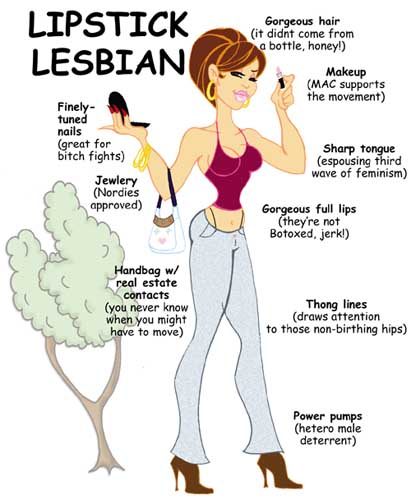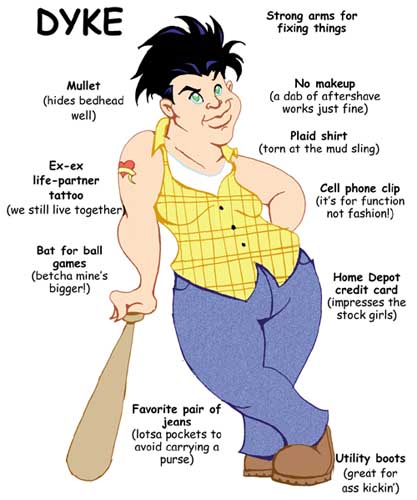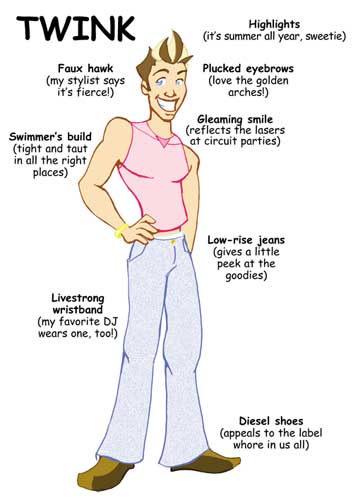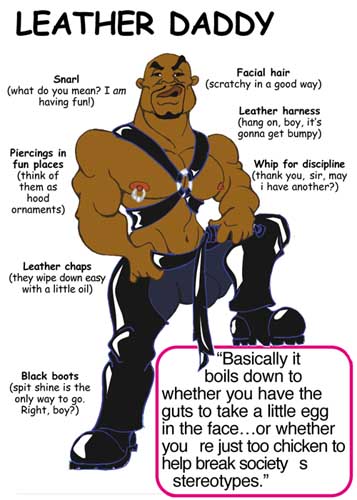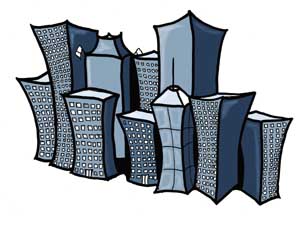-
- Report: Connecticut could lose $1 million a year if civil unions are allowed
- Video that raised conservatives’ ire to be distributed nationwide
- Gay-rights advocates file brief against 1913 Massachusetts law
- Washington Supreme Court hears same-sex marriage case
- Supreme Court to decide gay parenting case
- Gay couple sues for use of their photo in Internet ad
- National News Briefs
- World News Briefs
feature
Lisps, limp wrists & power tools
Redefining gay and lesbian stereotypes
Published Thursday, 17-Mar-2005 in issue 899
The inherent problem with writing about stereotypes is that, in doing so, one inevitably falls into acknowledging – and sometimes even affirming – generalizations about a group. And so, before a discussion of gay stereotypes can begin, be it light-hearted or otherwise, it is critical to understand that all stereotypes are based on some element of the community that exists. That is, there is pattern recognition. Typically, that is the element of a given community that is portrayed in the media, either through the news media or Hollywood.
For example, the stereotype of the lesbian being handy with power tools may offend a great number of those in the GLBT community. That being said, self-identified lesbians who are comfortable with and enjoy working around the house or on automobiles certainly do exist in society.
Many may find the stereotype of gay men being florists and hairdressers offensive. That being said, there are self-identified gay men who have built thriving careers as florists and hairdressers.
The point to make is that not all lesbians know the difference between a socket wrench and a monkey wrench, and not all gay men know the difference between daisies and daffodils.
Take this simple quiz. Take a pencil and a piece of paper and draw a chair. Chances are a great many drew a similar chair. Two factors may have influenced the drawing: our own cultural perception of the traditional chair, and our natural ability – or inability – to translate or communicate that ideal onto paper.
Likewise, when we talk about communities or cultures, we often rely on two critical elements: the depth of our past experiences and perceptions of what that culture is, and the breadth of our language to communicate through language.
And so, we come to a paradox: the idea that communities and cultures exist and are real, and the notion of looking at each individual as a unique reality.
There is no question that you can find members of the GLBT community in every aspect of American society: teachers, firefighters, members of Congress, actors, store clerks, clergy, professional athletes, cab drivers, parents, children, grandparents, aunts, uncles and even, if you are to believe the influential writer (and former sex researcher for Alfred Kinsey) C.A. Tripp, in his new book The Intimate World of Abraham Lincoln, a president. So why, then, does America appear to have such a set definition of the gay male or lesbian female?
In search of the answer, we turned to a number of recent events, popular culture and members of the San Diego GLBT community.
‘Gay or Asian?’: It’s in the ‘Details’
In last year’s April issue of Details magazine, a satirical piece appeared entitled “Gay or Asian?” asking readers to determine whether the model was gay or Asian. Part of the long-running “Anthropology” series by Whitney McNally, the “Gay or Asian?” piece incited an online petition protest that bombarded Details with tens of thousands of letters. On April 16, over 200 protesters picketed outside of the Details office.
Details magazine, which has a subscription of over 400,000 (including a large number of gay readers) has run McNally’s “Anthropology” series for some time. Other titles have included “Gay or British?” and “Gay or Jesus?” This is the first time, however, that media watchdogs have jumped on Details for their satirical approach to stereotypes since it began running in August 2003 (“Gay or Guido?”).
“When you see enough drag queens on CNN during their coverage of Pride parades, you begin to wonder if those are the only people brave enough to be out.” “What shocks me,” says Jeremy Gillins of Hillcrest, “is that no one has jumped on this before the ‘Gay or Asian?’ piece. Basically, society let this column go for over a year brandishing offensive gay stereotypes. It wasn’t until it was deemed racist that anyone stood up and said, ‘Enough is enough.’”
Gay or metrosexual?
He prefers cosmos to Coors, has a manicure every Thursday, shops exclusively at Nieman Marcus, and knows the difference between Van Camp’s brie and Bree Van De Camp. Is he gay?
“Absolutely not,” explains Stewart Johnson of Hillcrest. “That’s my straight brother [Tim] – the metrosexual in the family.”
The term “metrosexual” first appeared in writer Mark Simpson’s July 22, 2002 salon.com article on soccer star David Beckham. The piece entitled “Meet the Metrosexual,” describes a metrosexual as “a young man with money to spend, living in or within easy reach of a metropolis – because that’s where all the best shops, clubs, gyms and hairdressers are. He might be officially gay, straight or bisexual, but this is utterly immaterial because he has clearly taken himself as his own love object and pleasure as his sexual preference. Particular professions, such as modeling, waiting tables, media, pop music and, nowadays, sports, seem to attract them but, truth be told, like male vanity products and herpes, they’re pretty much everywhere.”
“My brother spends way more money on hair products, skin treatments and gym memberships than I ever will,” says Johnson. “But unless something really radical happens, I see his future as a very happy one with his wife and son.”
And did Johnson’s brother always show “metrosexual leanings?”
“Oh, totally,” explains Johnson. “When we were kids, he would get furious if he got his new shoes scuffed. He always had to have the ‘it’ brands. In college, we shared an apartment and I was always screaming, ‘Hello! I’m the gay one here! Mind if I have a shot at the mirror?’ And his TiVo is set to record every ‘Queer Eye for the Straight Guy.’ You should see him watch it. When you think of men yelling at the TV, you think of them sitting around watching football yelling at the quarterback to throw the ball. Not Tim. He’ll be, like, ‘Hey! Dumbass – rinse twice!’”
Aside from his impeccable style and skin tone, Johnson says there are no reasons to believe his brother will convert to homosexuality any time soon. “Which is really too bad,” concludes Johnson, “because the [gay] community would be lucky to have him.”
How many Ss in super?
Researchers at the University of Toronto recently took on the age-old question, “Why do some gay men sound so gay?” Linguistics Professors Henry Rogers, Ron Smyth and Greg Jacobs (York University) asked subjects to listen to recordings of 25 men, 17 of whom were gay. In 62 percent of the cases, the listeners identified the sexual orientation of the speaker correctly.
According to the findings, however, the “straightest-sounding voice in the study was in fact a gay man, and the sixth gayest-sounding voice was a straight man.”
Which, for Larry Williams of North Park, begs the question, “Who defines what sounds gay?”
In the University of Toronto study, several characteristics were identified as “sounding gay.” Prolonging or other alternations to /s/ and /z/ sounds subtly (commonly referred to as “lisping”), prolonging vowels or consonants (“Soooo fffabulous”), using a higher-pitched voice and emphasizing final-stop consonants were among those characteristics determined to be “gay sounding.”
“When did we decide that lisping was a sign of homosexuality?” asks Williams. “I mean seriously, every person who has a speech impediment is gay? That makes no sense whatsoever.” After pausing, Williams says, rather indignantly, “I mean, that makeths no thenths whatthoever.”
But the truth is, there are certain uses of language – both verbal and non-verbal –that are seen by society at large as “gay,” aside from just the aforementioned patterns in the University of Toronto study.
For example, using upward inflections, pursing lips and shaking the head emphatically when initiating a word, using vocabulary or particular expressions (“You go, girl”), and standing elbows akimbo, hands on hip.
“Let’s face it,” says Rick Spencer, of North Park, “when Jack [from “Will and Grace”] walks onto screen, you know he is supposed to be gay. Will, on the other hand, sometimes, I just think, ‘Is he really supposed to be gay?’”
Eric McCormack’s character does what some in the linguistics community describe as “code switching,” or switching between what is seen as “gay language” and “straight language.”
Code switching is nothing new, nor is it limited to gays and lesbians. In fact, to some degree, says linguistics student Adrian Rodriguez, everyone does it.
“Code switching means alternating between communication styles or patterns,” explains Rodriguez. “We see it all the time with adults and babies. Adults see a baby and start to talk ‘baby talk’ to them. It is the same way in the GLBT community. When we are around our friends, we use phrases and gestures that fit the situation.”
In her 2002 groundbreaking piece “Code Switching and Gay Speech Styles,” Caroline Bowen argues that there are a number of theories and suggestions as to why code switching occurs.
“Code switching is used to protect sexuality (in a new, unknown, unsafe or hostile environment); code switching is used to project sexuality (in a familiar, accepting or comfortable environment); code switching from standard production to ‘gay’ production is used as an indication of pride, a sense of community, unity and solidarity; code switching is used as a political statement; code switching is used as a ‘protection’ from, or barrier to, heterosexual ‘advances.’ Some gay men report code switching to gay production only when they are in the company of other gay men. Indeed, some say that their parents, employers and workmates, for example, have never heard them ‘talk gay.’”
“Basically it boils down to whether you have the guts to take a little egg in the face…or whether you’re just too chicken to help break society’s stereotypes.” Gay or homophobe?
“A guy walks into a gay bar and…” This may sound like the beginning of your typical heterosexist joke.
“So my friend stops off after work to pick up dinner for him and his partner,” explains Jason Moran of Hillcrest. “He decides that while he’s out, he’ll grab the gay newspapers a couple doors down at the neighborhood gay bar. You know, to see what’s going on that weekend. He quickly ducks in, grabs the papers, and is about to head out, when he hears this guy say, ‘Well, if that ain’t a closet queen, I don’t know what is.’ Now, you have to understand, this friend of mine is totally out with his family and the school where he teaches. Anyway, to make a long story short, my friend turns around, sees this overweight, middle-aged queen sipping his martini, drunk as a skunk, and says, ‘Excuse me? You talking to me?’ The drunk cackles back, ‘Hey, I just call ‘em like I sees ‘em.’ So my friend says, ‘Well, I guess that gives a whole new meaning to beer goggles.’”
Ba-dam-bum.
Of course, as Moran’s partner, Tim Levins, points out, “Now who’s the homophobe? You just called the guy a ‘queen’! And if you ask me, we’re our biggest problem. How many times do you hear someone say, ‘Take his gay card away’ if they don’t know something about Bette Davis movies or Judy Garland songs? Or make jokes about lesbians on a second date renting U-Hauls?”
Moran’s favorite expression, though, is the personal ad pick-up line, “Straight-acting gay dude.”
“What I love about that line,” says Moran, “is that it makes absolutely no sense. Like [Karamo] on this season’s ‘Real World.’ He is such a contradiction. On the one hand, he is all in [M.J.’s] face about racial differences, but he won’t date the gym trainer because he is ‘too gay.’ If I remember correctly, he said he likes ‘gay thugs.’ What are ‘gay thugs,’ anyway?”
Which brings us to a number of sub-cultures in the gay community that seldom get press: gay slobs, lipstick lesbians, and so-called Abercrombie Zombies.
“The funny thing is,” says Jerome Finney of Mission Hills, “I know more gay couples with kids than I do single gay men. I know more lesbians who drive European cars than tow trucks. That is the interesting thing about the gay stereotypes we see on TV and in the movies – they’re outdated. Think about the ‘70s and ‘80s, when gay characters were pathological predators or swishy comic relief characters.”
With shows like “Will & Grace,” “Six Feet Under” and “Survivor: Vanuatu” (contestants Ami Cusak and Scout Cloud Lee from last season were out lesbians), gay and lesbian characters are more integrated into the main plot lines of shows that mainstream America watch. Actress Sonja Sohn plays a lesbian of color, Detective Kima Greggs, on “The Wire”, one of the most talked-about crime dramas today.
The smash hit “Queer Eye for the Straight Guy”, which catapulted its Fab 5 into network NBC’s primetime “Must See TV,” draws mixed criticism in the gay community for its portrayal of gay-straight relationships.
“Don’t you think [‘Queer Eye’] just reinforces the gay-straight divide, where the gay guys know all about fashion and flowers and the straight guy doesn’t know squat?” wonders Finney. “I mean who in America really uses the word ‘couture’ or ‘shushing’ except gay guys?”
On the other hand, argues Levins, the fact that the show has such publicity helps break down long-held stereotypes.
“Can’t you just see Redneck Joe sitting on his sofa in the heart of Arkansas flipping channels when he comes across the TV ad for Pier One? He turns to his wife and says, ‘Hey, that there’s that guy from ‘Queer Eye.’ Then they go out and pick up some new napkin rings,” muses Levins. “I mean, when is the last time he used the term ‘queer’ in a sentence and knew what he was saying?”
Finney has to admit that some bi-products of the “Queer Eye” sensation have been positive.
“One thing I loved was that during the Super Bowl, it was all about taming things down and not getting in trouble,” says Finney. “And then here comes this Pepsi commercial with this great looking guy walking down the street. Everyone’s heads are turning, including Cindy Crawfords, when suddenly, Carson Kressley [“Queer Eye for the Straight Guy”] passes by, lowers his shades, and stares back after the guy, jaw dropped to the ground. And the best part was that no one, not one of my straight friends flinched.”
In fact, says Finney, one of his straight friends joked that Kressley probably had a better shot at getting the guy’s attention than Crawford.
“We have this heightened sense of maleness,” explains Moran. “And I am not talking about the hypermasculinity thing that Tom of Finland had going on, because if you go to a leather event, with all these amazing studs with their bulges, deep down, they are a bunch of loving, sweet, sensitive gay men. They may not cry when a guy breaks a paddle over their backside, but they’ll cry if he breaks their heart!”
What Moran is talking about is his belief that men today are coming to the realization that they can be a part of American society as fully-participating males. They don’t, as Moran puts it, feel the need to live in a “gay ghetto.”
“On the contrary,” explains Moran, “most of our friends are great guys, many of whom are dads, who went to the right colleges, are successful in their careers, want a better life for their children and grandchildren – who have all the family values they have in the red states – who just happen to wake up next to another man every morning. Do they go to the gym more often or buy more skin product than their straight counterpart? If they do, it’s not by much!”
And this year, “Queer Eye for the Straight Girl” comes to the small screen with fashion magazine editor and ex-model, out-lesbian film producer Honey.
“She’s smart, she’s beautiful, and she turns every head in the room,” says Ashley Frasier of North Park. “What I love about her is that she is who she is without shoving it in your face.”
Lesbian or senator from New York?
Comedienne Julia Sweeney introduced her unforgettable, sexually-ambiguous character, “Pat” on “Saturday Night Live” in the early 1990s. The sketch presented a central character whose gender was a mystery. Sweeney and collaborator Christine Zander later turned the character sketch into a book and feature film.
“What was funny about ‘Pat,’” says Joyce Medina of University Heights, “is that most people in America were debating whether ‘Pat’ was a male or a female. My friends and I knew the answer: ‘Pat’ was a lesbian!”
Sweeney’s character, a pudgy, glasses-wearing, whiner with unkempt curly hair, finds an equally-ambiguous character in the film named “Chris,” played by Dave Foley.
“In the final scene,” explains Medina, “Pat and Chris get married. Technically, you don’t find out who was what [gender]. That kind of stumped us. After all, last time we checked, two lesbians couldn’t get married!” Or perhaps, chuckles Medina, “it was Rosie and Kelli [O’Donnell] before Rosie and Kelli!”
Being a lesbian and being androgynous is nothing new, though, argues Samantha McCallum of Downtown.
“The whole ‘Ellen’ show was about this woman [Ellen] who was totally a sexual mystery,” says McCallum. “That is what made the show so funny. It was almost a disappointment when she came out because the show stopped being so funny.”
Not everyone, though, would agree with that.
“It was so liberating,” avers Vera Garcia of Hillcrest. “Here was this beautiful woman on this hit show who just came out to America. And she was so not a threat to anyone. Sure, she made her jokes about getting a toaster for recruiting and whatnot, but who would have thought?”
It was O’Donnell, though, who maintained an androgynous image for many years, becoming one of television’s highest-rated talk show hosts. And she didn’t exactly fit the lesbian stereotype. After all, she was a megastar, fawned over Tom Cruise and was a mom.
“Rosie was great because she just lived her life without defining herself,” says McCallum. “And she didn’t let other people define her by any stereotype, either. I don’t think she ever out-and-out lied [about her sexual orientation], I just think she had other priorities.”
Those priorities changed for O’Donnell, however, in the spring of 2002 as part of a protest against laws that prohibit gays and lesbians from adopting.
“It’s strange, though, to think of Rosie’s coming out as such a monumental event today,” says Garcia. “I mean, the [then-] Governor of New Jersey [James McGreevey] comes out and it makes the news for, like, a day max. Would anyone care if Hillary [Clinton] came out? We would probably be like, ‘Hey, so that’s what gave Bill [Clinton] the heart problems. Makes sense now.’ And that would be the end of it.”
Garcia agrees.
“I mean look at [Hillary Clinton],” says Garcia. “She has no idea how to fix her hair. She wears these skirt suits with clunky shoes. And she has bigger cajones than most men in Washington. Does that make her a lesbian?”
Last month, the GLBT community added one more TV icon to its “outed” family: Patty, one of twin sisters on “The Simpsons.” On the same night that ABC’s “Desperate Housewives” premiered Bree Van De Camp’s son’s first gay kiss, Homer Simpson was writing away to a mail-order preacher business so he could perform same-sex marriage. Patty arrives to tell sister Marge that she is getting married – to “Veronica.”
Like all good housewives in middle America, Springfield’s Marge has trouble dealing with her sister’s lesbianism. As it turns out, Marge ends up “outing” Veronica – as a man. In the end, “Veronica” says s/he only dressed up as a woman to play in the LPGA.
‘Chicken’ or the egg?
“You just can’t get around it,” says Joey Monroe of Hillcrest. “Stereotypes die hard. When you see enough drag queens on CNN during their coverage of Pride parades, you begin to wonder if those are the only people brave enough to be out.”
Monroe, who teaches at a local middle school, is not alone in his disappointment. While there is no question that young people in America have a growing number of GLBT role models, there are still certain areas that lack high-profile gays and lesbians.
In 1994, Ford Motor Company’s vice chair Allan Gilmour retired, after 34 years in the “corporate closet.” When he came out two years later, it was described as a “shocking moment for corporate America.” After all, up until a month before Gilmour retired, he had never even taken a phone call at the office from his partner, let alone acknowledged his sexual orientation.
Gilmour’s coming out sparked a flurry of headlines, leading Gilmour to wonder if he had made a mistake. Gilmour, who was still serving on five major corporate boards, including Prudential, Whirlpool and Dow Chemical, was understandably concerned – a concern he expressed repeatedly in the media.
In 2002, though, Gilmour must have had a hint of concern erased when he was pulled back out of retirement and placed in charge of Ford’s fledgling credit operations.
Today, there are a number of out executives in Fortune 500 companies. In this year’s March 15 issue of The Advocate, gay corporate leaders were profiled from MetLife Inc., Eastman Kokak Co., Wyndham International and Bank of America, among others.
One area that Details magazine hasn’t satirized in their Anthropology section is “Gay or Professional Athlete?” And that may be because there is simply nothing funny about it.
“Okay, so we have Martina [Navratilova] and [Greg] Louganis,” says Garcia, “but where are the ball players?” By that, Garcia means baseball, football and basketball. “Hank Aaron got called the ‘n-word’ as many or more times than he was called a ball player. Did that stop him? It gives a whole new meaning to ‘take one for the team.’”
Granted, there have been professional athletes who have come out of their own accord, including Rudy Galindo (figure skating), David Kopay (football), Billy Bean (baseball), Roy Simmons (football), Missy Giove (mountain biker) and Esera Tuaolo (football). But few have come out during their careers. Most cited their concern for their careers and endorsements as the primary reasons for remaining in the closet. Others have been outed unwillingly, such as Billie Jean King (tennis). Many well-known athletes who were struggling with reconciling their sexual orientation and their athletic prowess have attempted suicide, among them, Ed Gallagher (football) and Justin Fashanu (soccer).
The one area that seems to be on track for the most part is the music industry. While Tinsletown is still waiting on Tom and Sharon to take the plunge, musicians like Melissa Etheridge, Rufus Wainwright, the Indigo Girls, the Pet Shop Boys, Mary Gauthier and Sharon Isbin are tearing up the charts as out and proud artists.
“Basically it boils down to whether you have the guts to take a little egg in the face,” says McCallum, “or whether you’re just too chicken to help break society’s stereotypes.”
“Gay or Asian?” “Gay or County Singer?” “Gay or Democratic Frontrunner?” These are all dilemmas posed by McNally at one point or another. Jeremy Gillins has an answer: “If you ask me, and you did, I would like see the feature read, ‘Gay Asian Country Singer is Democratic Front Runner.’ It may not happen in my lifetime.”
Gillins pauses briefly, then breaks into a huge smile. “But that’s only because I don’t know any Asian country singers.”
|
|
Copyright © 2003-2025 Uptown Publications


